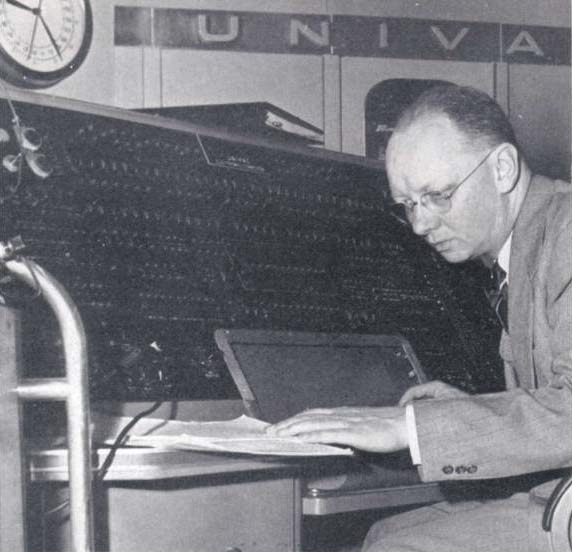Paul Herget

|
| Photo: SYSTEMS MAGAZINE, Jul-Aug 1955, contributed by Herb Grosch. |
This brief biographical sketch touches only those portions of Herget's work that were connected with the US Naval Observatory during Wallace Eckert's tenure, and with the Watson Scientific Computing Laboratory at Columbia University. Herget published voluminously; a bibliography can be found in Reference 2 below.
Paul Herget, 1908-1981, pictured above in 1955 at the console of Univac I, the first production electronic digital computer, working on computations to locate the outer moons of Jupiter, particularly Jupiter VIII (Pasiphae), extrapolating from the 1940-42 calculations¹ of Herb Grosch (see Computer, Bit Slices of a Life, Chapter 05, "2500 Hours on a Marchant"), which extended only to 1941.
Herget was an early practitioner of machine methods in solving scientific problems, a field pioneered by L.J. Comrie and Columbia University professor Wallace Eckert and dominated by astronomers who pushed 1930s-era tabulators, sorters, etc, in directions their makers never imagined.
When World War II broke out, Herget, a young astronomy professor at the University of Cincinnati, wanted to contribute his computational talents to the Allied war effort, approaching first the Army at Aberdeen Proving Ground, then the Naval Weapons Center at Dahlgren, Virginia. At Dahlgren he inquired about the Weapons Center's plans to use punched-card equipment; he was told that punched cards were used for payroll, "but they ain't no good" for calculations. So he figured "Boy, if you think they ain't no good, I'm not going to work for you" [Reference 2 below]. He went instead to Washington and joined Wallace Eckert at the Nautical Almanac Office of the US Naval Observatory from 1942 until after the war ended, where he helped to automate production of the American Ephemeris and Nautical Almanac (while Eckert himself tackled the Air Almanac) and also took on special projects such as calculation of spherical triangulation tables for locating the German U-boats that were taking such a heavy toll on Allied shipping in the Atlantic. Working at night (since the machines were used on the day shift for almanac production), Herget and Eckert did the calculations in three months, resulting in a reduction of the casualty rate from 30% to 6%. Herget always regarded the "submarine book" as his greatest accomplishment.
After the War, Herget returned and was named director of the Cincinnati Observatory and resumed his faculty position at the University of Cincinnati. Among other things he was involved in the annual "minor planet" (asteroid) ephemeris calculations for the International Astronomical Union, and in 1947 published a compilation of "Kleine Planeten" tables calculated at Columbia University's Watson Laboratory and elsewhere.
In the mid-1950s, Herget named a recently-discovered asteroid "Norc", after
NORC, the Naval Ordnance Research Calculator,
designed and built at Watson Lab and, for about ten years, the world's most
powerful computer. Herget was a big user of NORC after it left Watson Lab
for its Navy home at Dahlgren, Virginia,
employing it to calculate the ephemerides of Earth and other planets and
their moons, as well as asteroids.
___________________________
References:
- Herget, Paul, "Found - a 'lost' moon", SYSTEMS MAGAZINE (July-September 1955), pp.15-16.
- Osterbrock, Donald, and P. Kenneth Seidelmann, "Paul Herget 1908-1981", Biographical Memoirs of the National Academy of Sciences, v.57 (1987), pp.59-86.
- Grosch, Herbert R.J., Computer: Bit Slices from a Life, Third Millenium Books, Novato CA (1991) [57].
- Dick, Steven, "History of the American Nautical Almanac Office", The Eckert and Clemence Years, 1940-1958, in Fiala, Alan D., and Steven J. Dick (editors), Proceedings, Nautical Almanac Office Sesquicentennial Symposium, U.S. Naval Observatory, Washington DC, March 3-4, 1999, pp.35-46.
- Dick, Steven, Sky and Ocean Joined: The U.S. Naval Observatory 1830-2000, Cambridge University Press (2002), Section 12.2.
Onsite Links:
- Grosch, Herbert R.J., Computer: Bit Slices from a Life, Third Edition, 2003 (in manuscript).
- US Naval Observatory
- World War II American Air and Nautical Almanacs
- Watson Laboratory
- Kleine Planeten (Watson Lab)
- Minor planets for 1947, elements and opposition ephemerides (Cincinnati Observatory)
- IBM Forum 1948
- Astrometic Conference 1953
- NORC